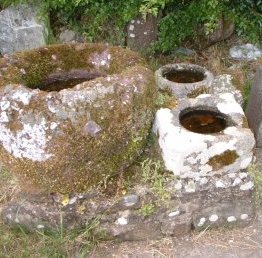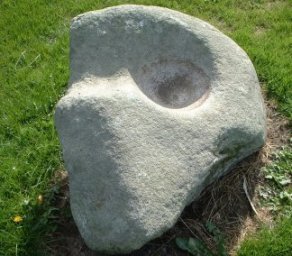|
Kilmokea
Cemetery |
|

|
Kilmokea is a very
ancient site in our parish. It is believed that there
was a large monastery here in the sixth century covering
over twenty acres. It was built on Great Island, when it
was an actual island and was of great importance as the
monastery controlled the River Barrow and ferry crossing
to County Waterford and Kilkenny. It's also close to
Waterford Harbour. We know that the Island or
Hervey's Island, as the norman Hervey de Monte
Marisco was granted the lands here, had its own town.Two
stone castles were built on the Island also.
The rampart of the Viking fort can still be seen as can
the church site and cemetery. No doubt the Vikings,when
they arrived in the eight century could see how
important this monastic site was. The remains of a
horizontal water mill was found here in 1968 when
Colonel Price was the owner and can be seen in the
garden behind Kilmokea House.
The cemetery contains items of great historical interest
and are well worth seeing. |
|

Bullaun Stones
|
|
These stones,called Bullaun Stones, are to be seen just
inside the entrance gate.There are three of them
here.They are bowl shaped and were probably used as
baptismal fonts or holy water fonts. The larger one
could have been used for grinding corn as a quern stone.The
monks also used them to grind medicinal herbs. The fonts were from the church which was here and the
remains of its outer walls can still be seen. |
|

High Cross
|
|
This is supposed to be the smallest
high-cross to be found in Ireland. It is 56
centimetres or about two feet in height. As you can see
it has a Latin cross inside the carved circle.It also
has some letters carved which are difficult to make out |
|

Sacrificial Stone
|
|
This is a picture of a sacrificial stone found within the
rampart. As you can see it has a bowl shaped depression
for the head and a channel for the neck to lie on.It's
also called a guillotine stone and is of granite and is 26
inches in length.It could
have been used to slaughter animals or humans. The celts
had the custom of headhunting.This cruel custom involved
beheading the enemy and taking it home as a trophy after a
battle. We know too that they offered human sacrifices to
their gods.
|
|

Base of Cross
|
|
This stone,which is in the cemetery, is probably the base
for a high-cross and is of granite. The cross itself is no
longer here.
|
|

Head Stone
|
|
This unusual head stone has
a skull and cross bones carved on it. On the back it has
an inscription and the year 1739. There is a history of
pirates attacking vessels on the River Barrow in this
area.
|
|

Stone sculpture
|
|
This stone with a head carved is in two
parts and can be seen just inside the main entrance to the
cemetery.
|
|
If visiting Kilmokea Cemetery please respect the
artefacts to be seen and that this graveyard is still in
use. Thanks to Tom Kent,Loughtown,Great Island for
his help. Seán Crowley.
|
|
Please
Return to Local History
|

